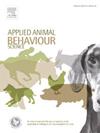Investigation of a potential link between UK equestrians’ understanding of learning theory, and their perception of and response to a problematic equine behaviour
IF 2.2
2区 农林科学
Q1 AGRICULTURE, DAIRY & ANIMAL SCIENCE
引用次数: 0
Abstract
Previous studies have demonstrated poor understanding of learning theory amongst equine professionals, but further work is required to gauge the level of understanding within the general equestrian population. How equestrians’ understanding of learning theory affects their perception of problematic horse behaviour, and strategies used to deal with it, are also unknown. Therefore, the aim of this study was to investigate the level of understanding of learning theory amongst the general equestrian population, and to explore how this relates to the way equestrians perceive and respond to a problem behaviour. An online questionnaire was completed by 672 UK equestrians, aged > 18 years old, who had owned/loaned a horse for over 1 year. The results indicate that UK equestrians have a poor understanding of learning theory; only 16 % of respondents correctly identified all four quadrants of operant conditioning from example scenarios. Equestrians with a poorer understanding of learning theory were significantly (P < 0.001) more likely to consider two scientifically implausible motivators (i.e. horse testing rider and horse dominating rider) as possible explanations as to why the horse in an example scenario was performing a problem behaviour (napping i.e. reluctance/refusal to move forwards as directed by the rider where the horse may plant its feet and/or only moves backwards or sideways in response to the cue to move forwards). Furthermore, equestrians with a poorer understanding of learning theory were more likely to use derogatory descriptors to describe the horse. Respondents who correctly identified only 1/4 quadrants of operant conditioning were significantly more likely to use the descriptors “naughty”, “cheeky” and “disrespectful” to describe the horse performing the problem behaviour in the example scenario (all P < 0.001). The use of derogatory descriptors to describe the napping horse was also significantly associated with an increased likelihood of using a punishment-based intervention to manage this behaviour (“naughty”, “cheeky”, “disrespectful”: all P < 0.001). The results of this study provide evidence for an association between a poor understanding of learning theory, blaming the horse for performing problematic behaviour, use of derogatory terms to describe problematic equine behaviour, and use of punishment in response to these behaviours. Further work is now required to establish if interventions to improve UK equestrians’ understanding of equine behavioural science would lead to improved horse welfare.
调查英国马术对学习理论的理解和他们对问题马行为的感知和反应之间的潜在联系
以前的研究表明,学习理论的理解差在马专业人士,但进一步的工作需要衡量的理解水平在一般的马术人群。骑手对学习理论的理解如何影响他们对马的问题行为的看法,以及用来处理它的策略,也是未知的。因此,本研究的目的是调查一般马术人群对学习理论的理解水平,并探讨这与马术者对问题行为的感知和反应方式的关系。672名年龄在>; 18岁、拥有或借出一匹马超过1年的英国骑手完成了一份在线调查问卷。结果表明,英国马术运动员对学习理论的理解较差;只有16% %的受访者从示例场景中正确识别出操作性条件反射的所有四个象限。对学习理论理解较差的骑手明显(P <; 0.001)更有可能考虑两种科学上不合理的动机(即马测试骑手和马支配骑手)作为可能的解释,以解释为什么马在示例场景中表现出问题行为(瞌睡,即不愿/拒绝在骑手的指示下向前移动,马可能会将脚放在地面上和/或只向后或侧向移动,以响应移动的提示前锋)。此外,对学习理论理解较差的骑手更有可能使用贬义的描述词来描述马。正确识别仅1/4象限操作性条件反射的受访者更有可能使用“顽皮”,“厚脸皮”和“不尊重”描述词来描述示例场景中执行问题行为的马(所有P <; 0.001)。使用贬义描述词来描述打盹的马也与使用基于惩罚的干预来管理这种行为的可能性增加显著相关(“顽皮”,“厚脸皮”,“不尊重”:所有P <; 0.001)。本研究的结果为以下三者之间的关联提供了证据:对学习理论的不理解、将问题行为归咎于马、使用贬义词来描述马的问题行为、以及对这些行为使用惩罚。现在需要进一步的工作来确定是否干预措施,以提高英国马术对马的行为科学的理解将导致改善马的福利。
本文章由计算机程序翻译,如有差异,请以英文原文为准。
求助全文
约1分钟内获得全文
求助全文
来源期刊

Applied Animal Behaviour Science
农林科学-行为科学
CiteScore
4.40
自引率
21.70%
发文量
191
审稿时长
18.1 weeks
期刊介绍:
This journal publishes relevant information on the behaviour of domesticated and utilized animals.
Topics covered include:
-Behaviour of farm, zoo and laboratory animals in relation to animal management and welfare
-Behaviour of companion animals in relation to behavioural problems, for example, in relation to the training of dogs for different purposes, in relation to behavioural problems
-Studies of the behaviour of wild animals when these studies are relevant from an applied perspective, for example in relation to wildlife management, pest management or nature conservation
-Methodological studies within relevant fields
The principal subjects are farm, companion and laboratory animals, including, of course, poultry. The journal also deals with the following animal subjects:
-Those involved in any farming system, e.g. deer, rabbits and fur-bearing animals
-Those in ANY form of confinement, e.g. zoos, safari parks and other forms of display
-Feral animals, and any animal species which impinge on farming operations, e.g. as causes of loss or damage
-Species used for hunting, recreation etc. may also be considered as acceptable subjects in some instances
-Laboratory animals, if the material relates to their behavioural requirements
 求助内容:
求助内容: 应助结果提醒方式:
应助结果提醒方式:


